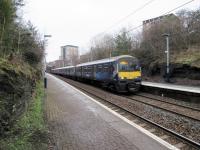This day in history 05 January
Images

Tickets and labels: Last day ticket 3184 from Hawick to Edinburgh and back on 5 January 1969 for the DMU leaving around 1815 to Edinburgh. Normally this would be the DMU which had worked ecs to Hawick on the Saturday evening from Appleby and would return to Carlisle with the morning "Scud."
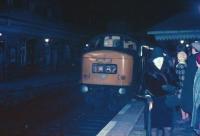
Hawick [2nd]: The last scheduled passenger train over the Waverley route, the 2155 sleeper service from Edinburgh Waverley to London St Pancras, rolls into Hawick late in the evening on a cold 5 January 1969 behind 'Peak' no 60 Lytham St Annes. The train was met by a large turnout of locals, waiting on the platform to say last farewells. [Editors note: I first saw this much reproduced image many years ago and, as is often the case with photographs incorporating character studies, had gradually formed a story in my mind to go along with it. Basically I became convinced that the fur-clad lady, whose face has just been illuminated by the flash of sprog photographer Bruce McCartney, is about to utter the words YOUNG MAN..!!! in the style of the late Dame Edith Evans, following which she proceeds to batter the said BMcC over the heid with her umbrella. I have so far resisted asking Bruce the question as I fear the truth may come as a disappointment after all these years. j]
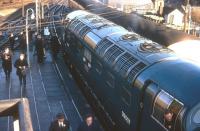
Hawick [2nd]: D9007 Pinza stands at Hawick on Sunday 5 January 1969 with the northbound RCTS (West Riding Branch) Farewell to the Waverley Route railtour. Originating from Leeds, the special ran to Edinburgh and back via the Settle & Carlisle and Waverley routes. The scheduled afternoon Edinburgh - Hawick DMU can be seen on the right.
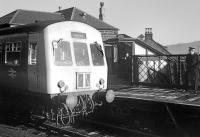
Hawick [2nd]: The 1155 (SuO) ex-Edinburgh Waverley DMU stands alongside the up platform at Hawick station on the afternoon of Sunday 5 January 1969, the last day of service.
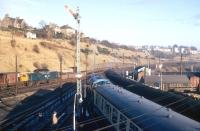
Hawick [2nd]: The RCTS Farewell to the Waverley Route railtour prepares to leave Hawick on 5 January 1969 behind Deltic D9007 Pinza. Hawick station pilot D8606 is standing over on the left while a dmu service from Edinburgh is on the right.
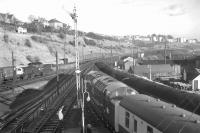
Hawick [2nd]: The much photographed RCTS Farewell to the Waverley Route railtour about to leave Hawick on Sunday 5 January 1969 behind Deltic D9007 Pinza. The station pilot, Clayton D8606 stands over on the left, while the the 11.55 (Sunday only) ex-Edinburgh Waverley DMU is arriving at the up platform on the right.
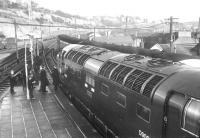
Hawick [2nd]: 'Excuse me sir, is this your train...?' Platform scene at Hawick on 5 January 1969 with Deltic D9007 Pinza at the head of the RCTS Farewell to the Waverley Route railtour preparing to leave for Edinburgh.

Tickets and labels: Memento of the last day at Hawick. A platform ticket purchased on 5 January 1969, price 3d.

Hawick [2nd]: Scene at Hawick on Sunday 5 January 1969 with Deltic D9007 Pinza leaving for the north with the RCTS Farewell to the Waverley Route railtour. Clayton D8606 is station pilot over on the left.
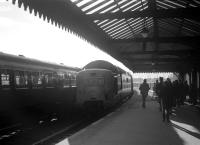
Hawick [2nd]: Deltic D9007 'Pinza' arriving at Hawick on 5 January 1969 with the northbound RCTS (West Riding Branch) 'Farewell to the Waverley Route' railtour.
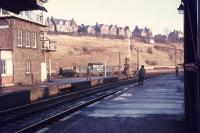
Hawick [2nd]: Platform scene at Hawick on Sunday 5 January 1969, the last day of scheduled services over the Waverley route. Featured in the photograph are duty signalman Gordon Hall see image [[21882]], who is having a conversation with Bruce McCartney on the up platform. Robin Barbour is standing on the northbound platform, with station pilot Clayton D8606 in the background.

Hawick [2nd]: Platform scene at Hawick station looking north on the last day... Sunday 5 January 1969. The gentleman on the left with Border Terrier Mickey is a Mr McCartney (senior) and the train on the right is the 11.55 (Sunday only) ex-Edinburgh Waverley, which was scheduled to arrive at Hawick at 13.15.
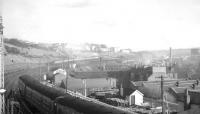
Hawick [2nd]: Looking north from Hawick on Sunday 5 January 1969. What might look like a steam special in the distance heading for Edinburgh is in fact Deltic D9007 Pinza, recently departed with the RCTS (West Riding Branch) Farewell to the Waverley Route railtour, which had originated from Leeds. In the forground an Edinburgh - Hawick DMU has recently arrived. See image [[47201]]
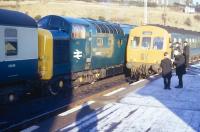
Hawick [2nd]: Platform scene at Hawick on a bright and sunny Sunday 5 January 1969, as Deltic D9007 'Pinza' prepares to leave for Edinburgh with the northbound RCTS (West Riding Branch) 'Farewell to the Waverley Route' railtour. An Edinburgh - Hawick DMU is standing at the up platform.
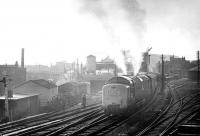
Hawick [2nd]: D9007 Pinza pulls away from Hawick on Sunday 5 January 1969 with the northbound RCTS (West Riding Branch) 'Farewell to the Waverley Route' railtour. The railway bridge over the River Teviot is visible in the left background.
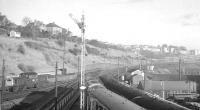
Hawick [2nd]: Deltic D9007 Pinza preparing to leave Hawick on Sunday 5 January 1969 with the RCTS Farewell to the Waverley Route railtour. The special ran between Leeds and Edinburgh via the Settle & Carlisle and Waverley routes. Hawick station pilot D8606 is standing over on the left.

Hawick [2nd]: Signalman Gordon Hall climbs down from the cab of Peak no 60 Lytham St Annes, following its arrival at Hawick at 23.27 on Sunday 5 January 1969 with the last scheduled service over the Waverley Route, the IM82 21.56 Edinburgh Waverley - St Pancras, conveying 10 coaches, including 2 sleeping cars. Signalman Hall had swapped shifts that night in order that he could be the one to pull the signal for the final train. It was not to be. Following reports earlier in the evening of demonstrations on the line in the Newcastleton area, the Hawick pilot (Clayton D8606) had been sent south just ahead of the train to check out the situation. Thus the signal to driver Fleming of Haymarket that night came in the form of an instruction from signalman Hall to pass the Hawick home signal at danger and proceed south under the section clear but junction or station blocked regulation. Gordon Hall is seen climbing down from the cab of no 60 having passed on this instruction just as a third figure enters the picture. That third person is a young David Steel MP, heading back to Westminster after the weekend, who is about to board the train (and whose powers of persuasion would be tested later at Newcastleton) see image [[18723]]. The train finally left Hawick for St Pancras shortly after midnight on the morning of Monday 6 January 1969.

Dinting: 6115 Scots Guardsman in the display shed at the former Dinting Railway Centre on 5 January 1980. Other locomotives on display that day included no 60019 Bittern that can just be seen sitting on the adjacent road.

Oubeck Loops: 40180 heads south at Oubeck, with soda ash tanks from Corkickle, on 5th January 1980. Withdrawn in June 1983, it succumbed to the torch at Crewe Works in January 1984.
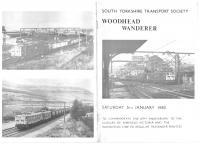
Woodhead: The commemorative hand-out for those partaking in the Woodhead Wanderer DMU farewell journey over the 1500V electrified route, 10 years after passenger services ended, and shortly before almost total closure of the line between Sheffield and Hadfield took place. The tour started at Sheffield Midland, and initially headed east via Tinsley Yard to Treeton Junction, where it reversed before then running west through the abandoned Sheffield Victoria station to Manchester Piccadilly, with a one hour stop at Dinting to visit the then Dinting Railway Centre en-route. The return journey was via the Hope Valley line, after a 3 hour early afternoon break in Manchester. See [[22507]].
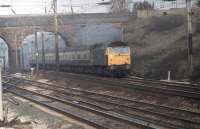
Farington Curve Junction: 47424 leads a Preston to Liverpool service on the Up Fast at Farington Curve Junction in January 1981. The former D1531 lasted exactly ten more years in traffic before withdrawal from Crewe in January 1991 and a further three in limbo before cutting at Booths, Rotherham in January 1994.
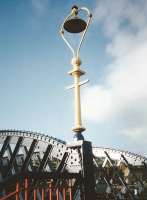
Stirling: Cast iron light fitting on the footbridge between plastforms 6 and 9/10 at Stirling in January 1995. Platform columns in this pattern see image [[20007]] had only recently been replaced. The fittings on the bridge survive, though they have heritage-style imitation gas lamps (made by Sugg, who made station gas lamps and are still around) and the paintwork is all black.

Stirling: Stirling on a frosty evening in January 1995 and a view south from the footbridge which connects the main station with Platforms 9 and 10. The building on the left did not survive much longer.

Dalreoch Tunnels: Helensburgh train heading west for the twin tunnels under Brucehill.

Fort William Oil Sidings: With plenty of power to spare the 67 from the sleeper takes empty oil tanks out of the sidings. This is a very complicated shunt involving many reversals. PS Who nicked my nice signal and replaced it with that new thing?

Calder Viaduct [Ravenscraig]: Memories of Ravenscraig. View west on 5 January 2006 over the bridge that once linked the hot metal and slag handling areas (no offence) photographed from a passing train travelling between Holytown and Wishaw.

Newton: A service for Glasgow Central, having run back from the reversing siding, crosses over at Newton to start its return journey in January 2007.

Carstairs: Stobart Rail 66411 Eddie the Engine approaching Carstairs from the south with the Tesco containers on 5 January 2007.

Newton: The passenger exit from the island platform at Newton on 5 January 2007, with the abandoned signal box standing beyond.

Paisley Gilmour Street: Looking towards Elderslie a Class 66 approached Pailsey Gilmour Street carrying coal bound for Longannet PS

Paisley Gilmour Street: 334009 at sits at Platform 2 of Paisley Gilmour Street with a Gourock service.

Paisley Gilmour Street: At one time there was a goods yard at Paisley Gilmour Street, which was situated at the same place as the car park and former Post Office. This shows the former entrance to it, which is now a track access point.

Glasgow Central: 156506 approaches Glasgow Central and is dwarfed by the passing Pendolino.

Carstairs: Northern liveried 321901 runs through Carstairs on 5 January 2007 signalled for the Edinburgh line.
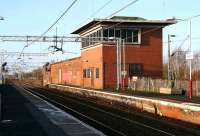
Newton: Looking across the running lines at Newton station to the redundant Newton signal box. View west on 5 January 2007.
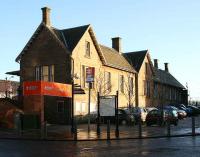
Lanark: Lanark station on a winter morning in January 2007.
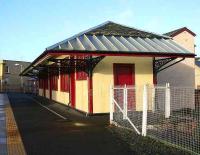
Lanark: The refurbished building on platform 2 at Lanark station looking smart in January 2007. See image [[46183]]
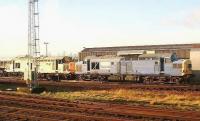
Motherwell MPD: Stored class 37s in the yard at Motherwell MPD on 5 January 2007.

Newton: View east from the platform at Newton station on 5 January 2007. On the far left is the WCML. In the centre a terminated service waits in the reversing siding at Newton East Junction pending its return to Glasgow. On the right a Milngavie train is approaching the station from Lanark.
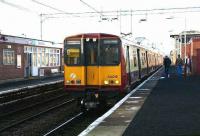
Newton: A terminating service from Glasgow Central arrives at Newton on 5 January 2007.

Lanark: Looking towards the buffer stops as a Milngavie service waits to leave Lanark on 5 January.
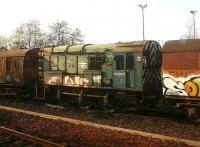
Motherwell MPD: BR liveried shunter 08927 languishes in the graffiti siding at Motherwell MPD on 5 January 2007. Photographed from a passing train.
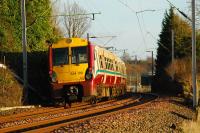
Ardoch Quarry Siding: Helensburgh-Glasgow train heading for the Brucehill tunnels west of Dalreoch. The Ardoch Quarry was on the left just beyond this cutting.
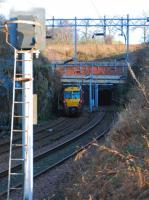
Dalreoch West Signal Box: 334023 approaches the northern Dalreoch tunnel, the original bore. The view is from the site of Dalreoch Tunnel signal box which controlled the western approach to the tunnel after the line was doubled but before the second bore was added. The box survived until 1926, becoming Dalreoch West box.

Newton: Departure from Newton on 5 January signalled for Newton West Junction and the Rutherglen line.

Carstairs: A class 92 takes a freight consisting of 4 containers and a dead class 66 locomotive south away from Carstairs on 5 January 2007.

Newton: Take this to your leader! Milngavie - Lanark service pulls into Newton station where an urgent message awaits, Jan 2007.

Newton: A GNER Glasgow Central - Kings Cross train bypassing Newton station on the WCML heading for Motherwell on 5 January 2007. The EMU in the background is a Newton terminating service laying over in the refuge siding pending its scheduled return to Glasgow. On the far right is the line to Hamilton and Larkhall.
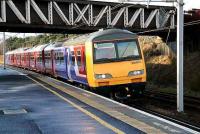
Carstairs: Northern liveried 321901 passing through Carstairs on 5 January 2007 prior to taking the Edinburgh line.

Motherwell MPD: Pair of EWS shunters sidelined at Motherwell MPD. Seen from a passing train in January 2007.
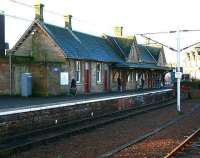
Lanark: The main station building at Lanark in January 2007. The building dates from 1855.

Biggar: The old station and signal box at Biggar in January 2007. Photographed from the south west looking towards Broughton. The area now forms part of a scrapyard.

Cambus: Loading up supplies to deliver them along the new Alloa line. Lots of work still required at level crossings.
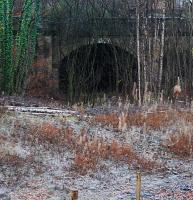
Alloa Harbour Junction: East portal of the Alloa Harbour Tunnel. This branch served the short-lived original terminus of the line at Alloa Ferry, prior to completion of the line west to Stirling. The main Alloa - Stirling line is out of shot in the foreground with the new and old Alloa stations behind the camera.

Dunfermline Queen Margaret: Hello Stranger! A visitor takes the outer Fife Circle service east towards Townhill yard.

Wemyss Bay: 334036 pulls away from platform 2 at Wemyss Bay on a sunny, frosty, January morning with the 1050 service to Glasgow Central.

Morecambe: Fresh snow at Morecambe, and more threatened, as 156469 waits to depart for Lancaster and 144011 is on immediate turnround to return to Leeds via Lancaster and Skipton.
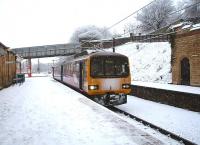
Lancaster: Wintry conditions as Northern Pacer 144011 arrives in Platform 5 at Lancaster prior to reversing for Morecambe. Despite the falling snow, which continued to affect public transport across Britain, this service, which had travelled via Skipton and Bentham, was only running around 20 minutes late.

Dalgety Bay: The East Coast 07.52 Aberdeen-London Kings Cross HST service, led by 43251, running through a snowy landscape near Dalgety Bay on 5 January 2010. The train was running approximately 40 minutes late at this point.
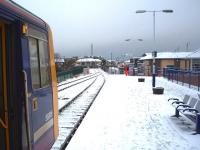
Morecambe: Looking towards the buffer stops at Morecambe. The headshunt, loop and self acting points were installed to allow running round of Heysham flask trains but are rarely used now that these run top and tailed.

Morecambe Promenade: The platform side of the refurbished Morecambe Promenade station. The picnic tables occupy the filled in former track area between the old island platforms. Parts of the building are now offices but the overall effect retains much of the old Midland railway character and the two doors under the awning replicate exits to the platform from the booking hall concourse. The concourse columns appear to be originals. The glass skylights cover the concourse area, now part of The Platform entertainment venue See image [[25012]].
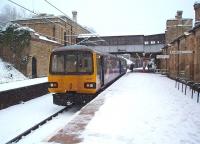
Lancaster: Having connected with southbound WCML trains on the opposite side of Lancaster's island platform 144011 is ready to continue its journey from Leeds to Morecambe. The snow ceased soon afterwards and compared to many other areas Lancaster got off lightly.
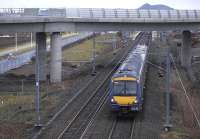
Edinburgh Park: 170414 passes underneath the new tramway bridge at Edinburgh Park on 5 January with a Glasgow Queen Street service. Tram rails have been installed on the bridge and approach earthworks completed.
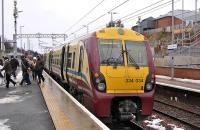
Livingston North: 334 034 disgorges its passengers at Livingston North on 5 January while working the 14.21 Edinburgh Waverley - Helensburgh Central.

Edinburgh Park: 158867 nears Edinburgh Park station with a Dunblane service on 5 January 2011. Arthur's Seat dominates the background.

Didcot Parkway: DBS 66041 running round its coal train alongside Didcot power station on 5 January following arrival from Avonmouth.

Cardross: As a result of damage caused by severe gales during the first days of January 2012 trains were disrupted between Dalreoch and Helensburgh. This is the storm damaged embankment at Ardoch looking east on 5 January.
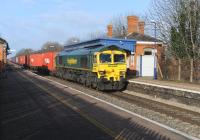
Cholsey: Freightliner 66535 passing eastbound through Cholsey Station on 5 January with a container train.
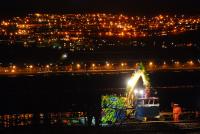
Cardross: Embankment repairs continue into the night east of Cardross. A road-rail crane lifts materials.

Didcot Parkway: DBS 66112 Oxford bound through Platform 3 of Didcot Station on 5 January with a rake of car transporter empties.

Cardross: A light locomotive heads west, past the embankment repairs near Cardross, on the first of two rescue missions to retrieve the electric trains trapped at Helensburgh Central. No wonder the Dalmuir-Larkhall service was withdrawn when four (?) trains were stuck at Helensburgh.
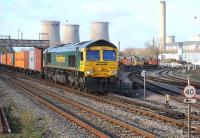
Didcot Parkway: Freightliner 66567 heading east after restarting its train following a long wait in the loop at Didcot on 5 January 2012.

Whitecraigs: The platform presentation of the Platinum award at Whitecraigs station on 5 January 2012. Left to right Steve Montgomery, Gary MacIntyre, Derek Robertson and Elaine Bell.
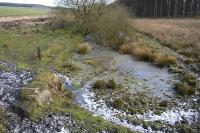
Gask Siding: View east from the B915 road along the flooded cutting of the West of Fife Mineral Railway's Gask branch in January 2012. On the left is a bridge abutment with a length of rail propped against it. A hundred years ago this was the terminus of the branch, with a transhipment platform connecting to a 'tramline' to Rescobie limestone quarry. Previously the line had continued to a triangular junction at Lassodie, near Kelty. Behind the camera is the former RN yard at Lathalmond from which rail traffic was withdrawn in 1971. The location is now the home of the Scottish Bus Museum and the Shed 47 Group.

Cardross: Electric stock, which was trapped on the Helensburgh line, is hauled to Glasgow past the embankment repairs near Cardross. There have also been repairs at the Dalreoch tunnels.

Dalreoch Junction: With the route west from Dalreoch currently closed to traffic the lines are becoming rusty. Meanwhile the Balloch line is open and here 334 029 turns north.
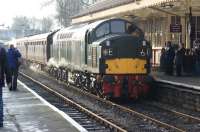
Bury Bolton Street: Class 40 no D335 enters Bury Bolton Street station on 5 January 2013 during the East Lancs 'BR Green Day'. With steam heating in operation it was a real delight to see this well turned out locomotive in action. Some 39 years ago it was one of the class 40s that I recall from Aberdeen Ferryhill MPD see image [[26445]]
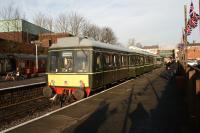
Bury Bolton Street: The destination panel says Aberdeen but the unit is nowhere near Aberdeen, has no intention of going to Aberdeen nor, to the best of my knowledge, has ever visited the Granite City. The Class 117 2-car DMU is standing at Bury Bolton Street station on the heritage East Lancashire Railway during the 'BR Green day' on 5 January 2013. It was operating a shuttle service to Heywood.

Ramsbottom: The driver and secondman lean out of the cab of D1501 at Ramsbottom station on 5 January, waiting for the down starter to clear for their train to proceed to Rawtenstall. Alongside on Platform 1 no D2062 is about to depart back to Bury with a 2 coach shuttle service.
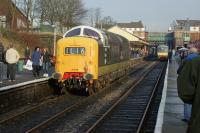
Bury Bolton Street: D9016 Gordon Highlander waits at Bury Bolton St on 5 January 2013 before moving off to the sidings at Castlecroft yard.
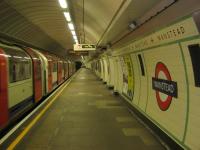
Wanstead: LUL 1992 stock on a Central Line short working to Newbury Park arriving at Wanstead station, east London, on the afternoon of Saturday, 5th January 2013. The eastern end of the Central Line, from a point just west of Leyton, runs over the former GER Loughton and Epping line as well as most of the Woodford to Ilford section of the Hainault Loop. The new tunnel linking Leytonstone with Newbury Park was complete before World War Two but then the scheme went into abeyance for the duration and the three miles of tunnel were converted into a secret underground factory for the manufacturing of air components by the Plessey Company. A narrow gauge railway was also completed. After the war, everything had to be removed and it was not until 14th December 1947 that Central Line trains first ran through the tunnels. Still, better late than never, the proposed similar electrification of the ex-GNR Alexandra Palace branch in north London as part of the LUL Northern Line, likewise begun before 1939, was never completed after 1945 and the line closed in 1954, leaving residents of Crouch End and Muswell Hill dependant only on buses ever since.
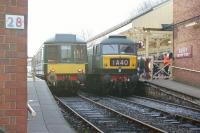
Bury Bolton Street: A 60s scene recreated at the ELR as D1501 prepares to depart from Bury Bolton St with a train to Rawtenstall at the Winter Diesel in January 2013.

Galashiels: Looking south over the site of the new Galashiels railway station on 6 January 2013, with the bus station opposite on the west side of Ladhope Vale and the Church of Our Lady & St Andrew standing beyond. The route continues under Station Brae in the left background towards Tweedbank.
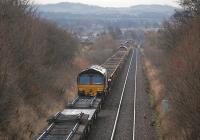
Kingskettle: Looking north to Kingskettle from Forthar on 5 January, with 66103, 66069 and 66206 each on a train of reclaimed track and ballast from Ladybank.
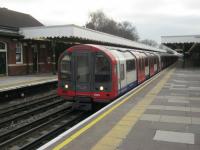
Fairlop: LUL 1992 stock no. 91105 with a Central Line service to Woodford via Hainault arriving at Fairlop station in Essex, on 5th January 2013. This station was opened by the GER in 1903 and was first served by tube trains in 1948.

Bow Road: Bow Road station, east London, LUL District and Hammersmith & City Lines, looking east on 5th January 2013. This shows the start of the steep incline which takes trains out of the cut-and-cover tunnel and up to where they begin to run alongside the ex-LTSR tracks with Hammersmith & City Line trains terminating at Barking while District Line trains go all the way through to Upminster. From 1905 until 1939, District trains ran all the way from Ealing Broadway to Southend On Sea, over the LTSR, changing from District electric locomotives to LTSR (LMSR from 1923) steam locomotives at Barking. The service was withdrawn as a World War Two economy and never reinstated after 1945. The western end of the platforms are inside the tunnel, this section of the line having opened as the Whitechapel & Bow Railway on 2nd June 1902.
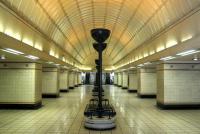
Gants Hill: The lower concourse between the platforms at Gants Hill station, on the eastern extension of the LUL Central Line between Leytonstone and Newbury Park, on 5th January 2013. This opened on 14th December 1947 in the last month of the LPTB and was an attempt to liken it to the stations on the Moscow Underground. The tunnels on this section were more or less complete at the outbreak of World War Two but were converted into a secret underground factory, three miles long, for the manufacturing of aircraft components by the Plessey Company. A narrow gauge railway was laid to transport the materials. Work resumed on the Central Line extension almost immediately the war finished and the concrete flooring and narrow gauge tracks had to be removed.
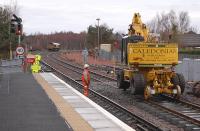
Ladybank: Looking north at Ladybank Station during track renewal on 5 January 2014. DBS 66107 stands in the backround.
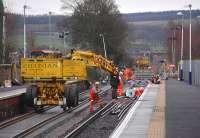
Ladybank: Looking south at Ladybank Station during track renewal works on 5 January 2014.
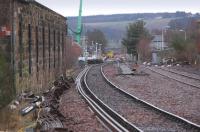
Ladybank Works: Looking south to Ladybank Junction past the ruinous E P & D workshops on 5 January - looking like the left hand line might be realigned through the middle of the formation.
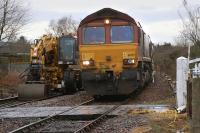
Ladybank: 66175 waits with a train of ballast hoppers on the Newburgh line north of Ladybank station on 5 January during track renewal works. See image [[45867]]

Buxton: Looking north east from the end of platform 2 at Buxton station on a relatively quiet 5 January 2015. In the distance a class 66 can just be seen taking a northbound freight past Buxton signal box.
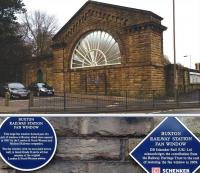
Buxton: The famous fan window at Buxton on 5 January 2015, with plaque details below. See image [[31150]]
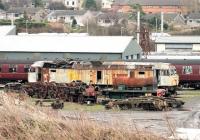
Carnforth: Sorry looking Brush Type 4 47194 Bullidea, stored at Carnforth for nearly ten years now, stands alongside a part dismantled 0-4-0ST and the chassis of a Bulleid Pacific on 5 January 2015. The latter is probably 34073 249 Squadron which is undergoing restoration by West Coast Railways.
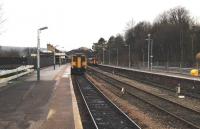
Buxton: Looking back along platform 2 at Buxton towards the buffer stops on 5 January 2015. The 1229 to Manchester Piccadilly is awaiting its departure time.

Carnforth: A tired and well worn 47368 stands in the scrap and recovery area at Carnforth Depot on 5 January 2015. The ex-Fragonset Brush 4 was purchased by West Coast in late 2006 but hasn't run since and is slowly losing its components to other West Coast operational locos. See image [[40169]] A Barrow bound TPE 185 runs past the site in the background.

Rufford: The last Preston - Ormskirk round trip of the day on 5 January 2015 seen on the outward journey calling at Rufford.
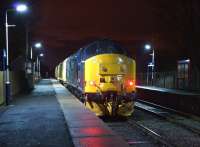
Rufford: A Network Rail test train waits in the loop at Rufford whilst working from Crewe to Derby via a multitude of places in the north-west on 5 January 2015. The wait is for the last Ormskirk to Preston Northern service to arrive so that the test train can access the single line to Ormskirk.
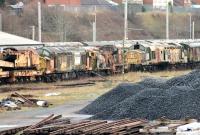
Carnforth: Two woebegone EE Type 3s stand in a line of stored stock at Carnforth on 5 January 2015. Loadhaul liveried 37517 is buffered up to an old 0-6-0F fireless steam locomotive that once worked at Lancaster Power Station see image [[27042]]. Next in line is a centre cab diesel shunter and then Railfreight liveried 37165.
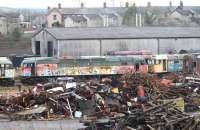
Carnforth: 47776 stands among the scrap and other stored locos in the component recovery area at the West Coast Railways Carnforth Depot on 5 January 2015. The RES Brush 4, which has been here since 2007, is flanked by 47368 and 47526 with operational shunter 08418 just visible behind.
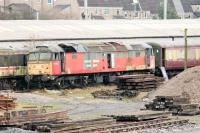
Carnforth: Another West Coast Railways spares donor photographed at Carnforth on 5 January 2015. Former Rail Express Systems Brush Type 4, 47492 (D1760), stands among other withdrawn locos providing parts to keep the West Coast main line Class 47 fleet in service.
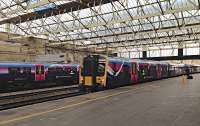
Carlisle: Following a northbound Pendolino into Carlisle on 5 January was this TPExpress with Lockerbie as the destination. The Newcastle line was also closed so it was pandemonium with buses outside. The Virgin staff were very helpful.
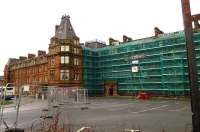
Ayr: Barriers and scaffolding around Ayr's Station Hotel in January 2016. Built by the GSWR in 1866, the grade 2 listed building, which forms an integral part of Ayr station, closed in 2013, since when it has begun to show considerable signs of neglect. The current activity is the result of a dangerous buildings notice served on the current owners by South Ayrshire Council.
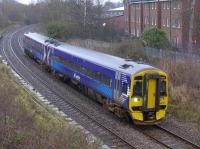
Duddingston: 158701 passes the closed Duddingston and Craigmillar Station with a presumed empty stock working to Haymarket Depot (didn't show up onrealtimetrains ...) and passes former rail-served breweries.
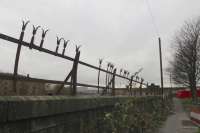
Partick Central: Remains of Caledonian Railway security fencing atop the wall of the former goods depot. No need for CCTV, just seek out the individual with 'life-changing injuries'.
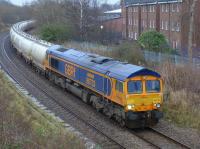
Duddingston: GBRF 66733 passes the closed Duddingston & Craigmillar Station with the North Blyth to Fort William Alcan train on 5 January 2016.
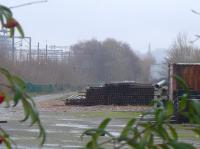
Balgreen [Tram]: The storage yard on the south side of the E and G near the Balgreen Road tram stop contains rails and poles for the next phase of construction.
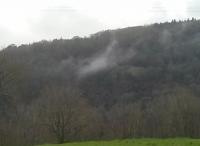
Lydbrook Junction: On a damp morning the cold air from the abandoned tunnel leading to Lydbrook Junction condenses into a cloud. The tunnel portal is below left of the cloud, behind the trees. The earthworks right of the cloud are the remains of lime kilns on Coppett Hill.
Note from S. Neave: The air in Lydbrook tunnel is warmer, not colder. That's why it's water vapour condenses in the colder outside temp (like a steam engine).
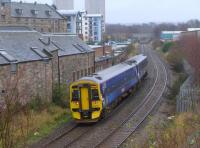
Duddingston: 158701, after passing the closed Duddingston and Craigmillar station, passes the former rail-served breweries.
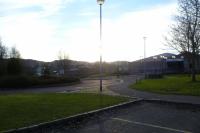
Hawick [2nd]: Looking to Carlisle - where's the Deltic? It was a coincidence that I was at the Hawick Leisure Centre today just about the time, to the hour, that 48 years ago I stood and watched the Deltic from Carlisle appear. See image [[47201]].

Vattholma: ASEA RC 4 loco of Green Cargo, the SJ freight subsidiary, hauls the empty aviation fuel tank train at -17 degrees Celsius. It also raised an enveloping cloud of powdery snow as it passed. The embankment of the original alignment is visible to the right of and parallel to the replacement 2 tracks.
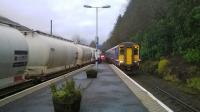
Arrochar and Tarbet: On 5th January 2018 Scotrail 156477 arrives at Arrochar and Tarbet with a train for Oban passing a GBRf Class 66 awaiting clearance for its onward journey hauling empty alumina tanks from Fort William to North Blyth.
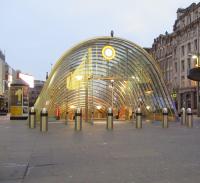
St Enoch [Subway]: The impressive entrance to St Enoch subway seen on a grey January dawn. I hadn't noticed the owl at the time. It's either a remarkable sighting for this urban location or a plastic one to scare smaller birds off the glass roof. I think I know which is more likely.

Kentish Town [LUL]: LUL 1995 stock on a Northern Line service to Kennington via Charing Cross at Kentish Town station in north London, an interchange with National Rail services, on 5th January 2019. This station opened with the line on 22nd June 1907 and the platforms are sited one above the other, the southbound (seen here) being below the northbound.
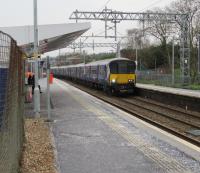
Cumbernauld: A Dalmuir service snakes out of the reversing siding and into Cumbernauld station on 5 January 2019. Most passengers here though are more interested in the direct trains to Queen Street.
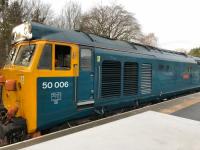
Tweedbank: I took a Flat Rate ticket to Tweedbank on 5th January 2019, got off at Galashiels and walked down to Tweedbank, only to find the 13:01 back to Waverley had been cancelled and this came down the line. 50006/50007 took it down and 50011/50049 took it back.
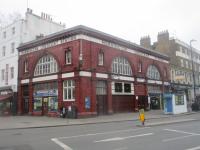
Mornington Crescent: Exterior of Mornington Crescent station, now part of LUL Northern Line, opened on 22nd June 1907 and one of many 'tube' stations designed by Leslie W. Green, the London Underground's Chief Architect of the Edwardian period who died in 1908 aged only 34, on 5th January 2019.
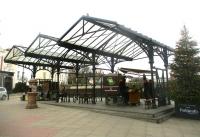
Kentish Town: These former platform canopies at Kentish Town station in north London now provide shelter for an al fresco coffee bar on the bridge over the Midland main line, seen here on 5th January 2019. The entrance to the LUL Northern Line station is just to the right.
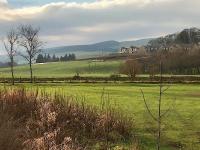
Stow: Spot the train... I intended to photograph the rail tour from Birmingham passing through Stow station but heard its horn as I finished my lunch, so this will have to do. It is there (honestly).
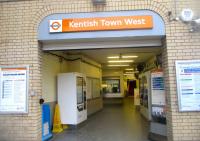
Kentish Town West: Entrance to Kentish Town West station, now part of London Overground, on 5th January 2019. This station was added to the Hampstead Junction Railway of 1860 in 1867; the platforms and buildings were wooden and had fallen into an advanced state of disrepair by the mid-1960s, rich in dusty unused waiting rooms. Very atmospheric with the then rattly Class 501 EMUs on what was then BR's Broad Street to Richmond line, listed for closure by Beeching. After the line was reprieved, the station was burned down by vandals in 1971. It wasn't until 1981 that new platforms were opened here, trains running non-stop between Camden Road and Gospel Oak stations for ten years.
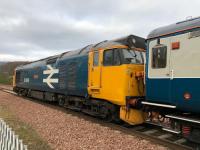
Tweedbank: 50011/50049 waits to take the 'Waverley Re-union' special back out of Tweedbank. Seen here from the south side of the line west of the station.

Plates, signs, notices etc: ScotRail may be having a few difficulties running trains at the moment, but it is good to see it has got the right priorites: a service to label teddys (sic) in case of separation. Poster seen on 5 January 2019.
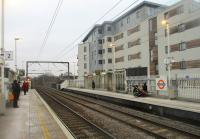
Kentish Town West: The 1981 station at Kentish Town West, now part of London Overground and devoid of any aesthetic quality, looking towards Stratford on 5th January 2019. The original 1867 station with its wooden platforms, waiting rooms and canopies, was burned down by brain-bypassed vandals in 1971 and for 10 years there was no station here.
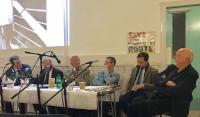
Stow: With the gates of the infamous Newcastleton level crossing seen projected in the background, the speakers at an event held in Stow on 5th Janary 2019 to commemorate the 50th anniversary of the closure of the Waverley route included (L to R): Andrew Boyd (he of the lum hat and the coffin at Hawick), Rae Montgomery (ex B.R.), Lord Steel (former local MP), Kim Elliot (part of the December 1968 delegation to Downing Street and son of campaigner Madge Elliot), Nick Bethune (Campaign for Borders Rail) and author and campaigner David Spaven. A most interesting afternoon with contributions from the floor from others who were involved, and a tantalising glimpse of what the future might be.
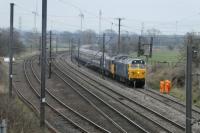
Quintinshill Loops: The two Class 50s on the 'Waverley Re-union' special in the loop at Quintinshill on 5th January 2019.
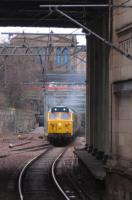
Edinburgh Waverley: Rare visitors to Edinburgh: a pair of Class 50s draw the 'Waverley Re-Union' charter from Birmingham New Street to Tweedbank into Platform 9 at Waverley on 5th January 2019 - the 50th anniversary of the last day of operation of the Waverley Route.

Tweedbank: Returning to the Borders for the first time in more than 50 years, 50007 Hercules is an object of admiration at Tweedbank on 5th January 2019. Kenneth Gray's (2009, unpublished) 'Diesel locomotives known to have worked into or through Hawick' records that, as D407, it was one of twelve of the 50-strong Class 50 fleet to have traversed the Waverley Route, almost certainly in June or July 1968, during a signalmen's strike on the northern section of the WCML.
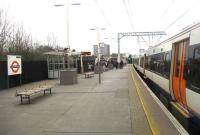
Camden Road: 378219 with a London Overground service to Stratford at Camden Road station, north-west London, on 5th January 2019. This was once an island platform with a further side platform on the far side behind the fence, abandoned many years ago.
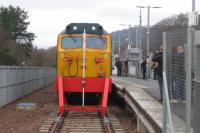
Tweedbank: Static - as opposed to fast-moving on its previous appearance on a diverted WCML train more than 50 years earlier - 50007 sits at the head of the Pathfinder Tours charter which reached Tweedbank 36 minutes early on 5th January 2019. Ironically this was due to the unplanned cancellation (due to staff shortage) of the 11.54 ScotRail service from Waverley. This led to many a frustrated lineside photographer! See image [[67063]].
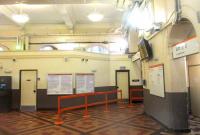
Camden Road: The refurbished ticket hall at Camden Road station, north London, now part of London Overground, on 5th January 2019.
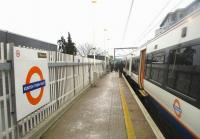
Kentish Town West: 378219 with a London Overground service to Stratford arriving at Kentish Town West station on 5th January 2019.
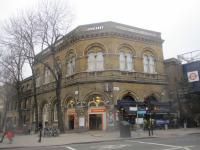
Camden Road: The splendid Victorian entrance building to Camden Road station, north London, now part of London Overground, on 5th January 2019. This was opened on 7th December 1850 as Camden Town by the East & West India Docks & Birmingham Junction Railway (renamed to the much more simple North London Railway in 1853) and was renamed Camden Road exactly 100 years later in 1950. The old name is still engraved on the walls above the windows.
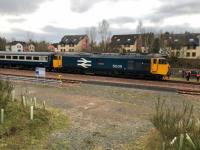
Tweedbank: 50011/50049 seen at the west end of Tweedbank station in a view looking south. 'Tweedbank Junction' is off to the right.
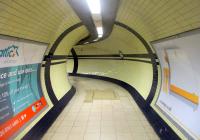
Mornington Crescent: Subterranean passageway from foot of lift shafts to platforms at Mornington Crescent station, LUL Northern Line, on 5th January 2019.
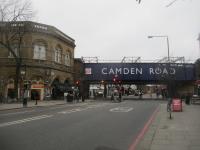
Camden Road: Looking north up Camden Road with the North London Railway bridge and Camden Road station (on left) in background, now part of London Overground, on 5th January 2019.
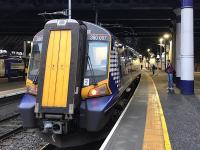
Glasgow Queen Street High Level: 380007 about to execute a nifty departure for Edinburgh via Cumbernauld after arriving slightly late on 5th January 2019 for what is a fairly tight turnaround anyway.
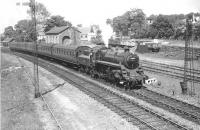
Busby: Standard Mogul 76004 leaving Busby on 9 July 1955 with a train for East Kilbride.
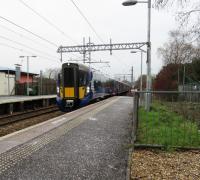
Cumbernauld: An Edinburgh to Glasgow service pulls into Cumbernauld on 5 January 2019. In my (necessarily) short experience of these service loadings seem rather light, at least outwith peak times. An opposite working was diesel, so there are still stock as well as reliability issues.
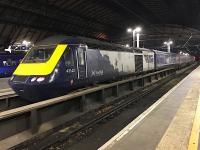
Glasgow Queen Street High Level: The 1630 Aberdeen to Glasgow Queen Street HST service with 43143 leading, seen at platform 6 having arrived a few minutes late on 5th January 2019. It would shortly depart for Eastfield HS.
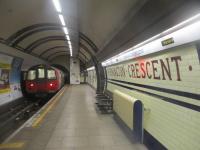
Mornington Crescent: LUL 1995 stock with a Northern Line service to Kennington via Charing Cross departing from Mornington Crescent station on 5th January 2019. This station was cited for closure by London Transport in 1958 but was reprieved although it was closed at weekends from 1970. On 23rd October 1992, it was temporarily closed for refurbishment and rebuilding of the lifts and reopened full-time on 27th April 1998. Until 1966, trains to the Edgware branch of the Northern Line passed through without stopping.
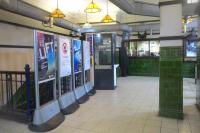
Mornington Crescent: Ticket hall at Mornington Crescent station, LUL Northern Line, on 5th January 2019. The station was closed between 1992 and 1998 for refurbishing and rebuilding of the lifts.

East Kilbride: A 4-car 156 about to return to Glasgow on 5 January 2019. East Klbride is a terminus crying out for a second patform, but I suppose to be effective the doubling would have to extend to the Hairmyres loop (or, preferably, Busby).
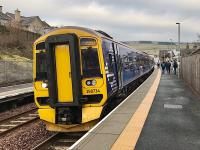
Stow: 158734 on the 1209 service from Edinburgh to Galashiels about to depart from Stow on 5th January 2019.
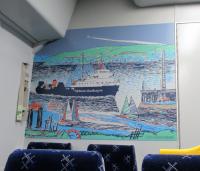
Interiors: MV Saturn about to ram Gourock pier, one of a series of panels on Class 320s by the artist Jimmy Cosgrove. Curiously this commission does not appear on his online CV though they are surely his most-seen works.
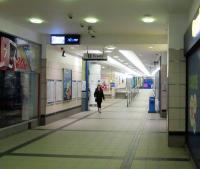
Argyle Street: The entrance passageway to Argyle Street station, seen on 5 January 2019.
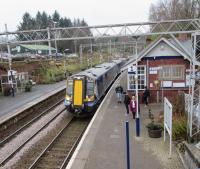
Whitecraigs: If Class 314s are missing from the Neilston branch it is a sure indication that they really are on their way out. A Class 380 calls with a Glasgow service on 5th January 2019. There has been some pretty comprehensive devegetation recently and the station is not looking quite so sylvan.
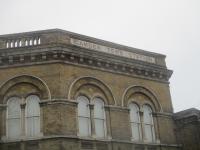
Camden Road: A closer view of the magnificent entrance to Camden Road station, now part of London Overground, showing the original name of the station, Camden Town, which it bore from its opening in 1850 until renamed 100 years later, seen here on 5th January 2019.
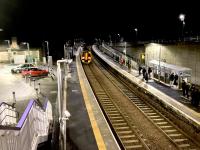
Stow: Passengers wait on the up platform for a retimed 1744 as the 1741 departs for Galashiels and Tweedbank on 5th January 2019. While the refurbished station may lack some of the ambience of its previous incarnation, the new lighting certainly makes photography easier at night.
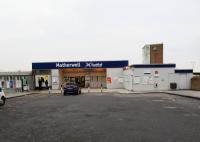
Motherwell: The forecourt at Motherwell station, seen on 5 January 2019. This area is due for a multi-million pound development to create a transport hub, as we will have to get used to calling them. It's certainly not a very welcoming spot at the moment.
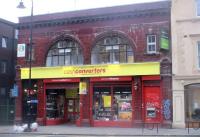
South Kentish Town: The entrance to the former South Kentish Town station, now in commercial use, on 5th January 2019. This station opened with the Charing Cross, Euston & Hampstead Railway on 22nd June 1907 and was originally to have been called Castle Road; this name was painted on the platform wall tiles prior to opening and then had to be covered up with the new name. It lasted for only 17 years; on 2nd June 1924 a strike began at Lots Road power station which saw none of the stations on the Highgate branch open. When the strike came to an end on 5th June 1924, while the other stations reopened, South Kentish Town remained firmly shut and has done so ever since. For those in the know, the gap in the tunnel walls still indicates the site of the platforms of this long lost London Underground ghost station.
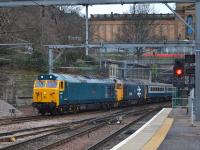
Edinburgh Waverley: 50007 and 50049 (alias 50006 and 50011) emerge from The Mound tunnel into Waverley Station with Pathfinder Tours 'The Waverley Re-Union' from Birmingham New Street to Tweedbank.
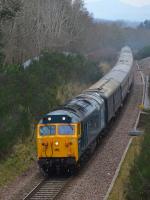
Gorebridge: 'The Waverley Re-Union' from Birmingham New Street to Tweedbank nears Gorebridge hauled by 50006 with 50011 on the rear.
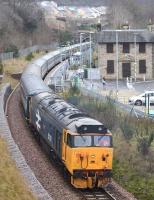
Gorebridge: 50011 (50046) brings up the rear of 'Pathfinder Tours 'The Waverley Re-Union' from Birmingham New Street to Tweedbank.
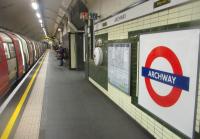
Archway: LUL 1995 stock on Northern Line train to Morden via Bank calling at Archway station on 5th January 2019.

Clarkston: An East Kilbride service calls at the one-time Clarkston and Stamperland on 5 January 2019. The 'Stamperland' was added to distinguish it from Clarkston (Lanarks).
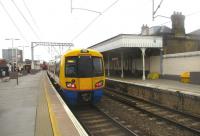
Camden Road: 378219 with a London Overground service to Stratford departing from Camden Road station, North London, on 5th January 2019. This station opened in December 1850 as Camden Town and was renamed 100 years later in 1950. It is still possible to see the old name engraved on the walls of the surviving and quite splendid original NLR station. Most of the other stations had theirs demolished and replaced with ghastly concrete blocks resembling more a public urinal than a railway station.

Woodacre Crossing: Services no longer required. LSL Type 1s D8107 and D8096 went to Scotland before Christmas (See image [[75264]]) to work a January railtour. However, the stricter lockdowns prevented this and they returned to Crewe on 5th January 2021. Something went amiss at Carlisle as they were originally going to work south via the Cumbrian Coast but ran via Shap with D8096 dead and cab to nose behind its stablemate. The pair are seen at Woodacre. Photographed incidental to daily exercise permitted under Corona Virus legislation.
Events
Events from the chronology which occured on this day. This generally lists events before 1995, the creation of the website.
News
These are old news items which which occured on this day. This generally lists events after 1995, the creation of the website.
| Year | Companies | Description |
|---|---|---|
| 2005 | Eurostar reports busiest year yet [BBC News] | The Channel Tunnel rail company reports that a busy Christmas boosted passenger numbers to record levels in 2004. |
| 2006 | Virgin sets £20 flat fare to beat rail strike [Scotsman] | VIRGIN train bosses have introduced a £20 walk-on fare in an effort to cope with workers^ industrial action. |
| 2009 | Crash driver killed on rail line [BBC News Item] | A 30-year-old woman was killed when her car ended up in the path of a train at a level crossing in Lincolnshire after it was in collision with a van. [From Mark Bartlett] |
| 2010 | Snow derailment problems continue [BBC News] | Train services between Inverness and Aviemore continue to be disrupted after a freight train was derailed at a Highlands station. |
| 2010 | Rail worker admits fire charges [BBC News] | A 45-year-old rail worker appearing at Inverness Sheriff Court admits to setting fire to his firm^s offices. |
| 2011 | Minister to face MSPs over role in 24hr rail freight route [Herald] | Scotland’s new Transport Minister is to face questions from MSPs over his role in promoting a controversial railway that residents claim has led to their sleep being disturbed at night. |
| 2011 | Revamping Arnside Viaduct - public roadshows [Network Rail] | This spring Arnside viaduct is being revamped for the 21st century. During January 2011 Network Rail will be hosting a series of public drop-in sessions, providing neighbours of the viaduct with the opportunity to talk to us about the essential improvement work being carried out. |
| 2012 | Whitecraigs named top station in Scotland [Railscot] | Whitecraigs station in East Renfrewshire was today named as the top station in the country by Keep Scotland Beautiful, the environmental charity. The organisation has spent six months assessing all 346 stations in Scotland on issues ranging from clearing litter to recycling, waste management, and community links. Assessments to Bronze, Silver or Gold status were available in Keep Scotland Beautiful’s first-ever Tidy Station Standards programme. |
| 2012 | Stations tee off with upgrades [Blackpool Gazette] | DILAPIDATED station platforms are set to have thousands spent on them as the Fylde gears itself up for this summer’s Open Golf. Almost £100,000 is set to be spent on projects to improve Lytham, St Annes and Ansdell stations, but councillors are warning the projects need to continue beyond July’s tournament. Ansdell ward councillor Ben Aitken said: “We have to be pleased with what’s happening now, and I think the local people who use the station will also be pleased. “The problem of course, once the golf has finished, is the maintenance, because I don’t want the stations to fall back into a wilderness. “ All three stations are on the Blackpool South line, and seen as key arrival points for golf fans heading to Royal Lytham and St Annes. Fylde Council is putting £42,500 towards the project, the Local Strategic Partnership is providing £40,000, Lancashire County Council is giving £10,000 and St Annes Town Council has agreed to provide £5,000 to St Annes and the South Fylde Community Rail Partnership £5,000 towards Lytham. [From Mark Bartlett] |
| 2012 | Chinese 500 km/h supertrain on test [Railway Gazette] | CHINA: CSR Qingdao Sifang unveiled an ultra high-speed test train in December. As foreshadowed in the January 2011 edition of Railway Gazette International, the six-car trainset is intended to give engineers the opportunity to research train and track behaviour at speeds up to 500 km/h. |
| 2013 | Rothes colliery: 50 years on [BBC News] | It is 50 years since the closure of Rothes Colliery, the reason for building the new town of Glenrothes, and perceived to be one of the costliest industrial mistakes in Scotland. |
| 2013 | Timelapse of Crossrail demolition of bridges [BBC News] | Three bridges have been demolished in preparation for the arrival of new electric Crossrail trains. SEE VIDEO LINK |
| 2014 | ‘I’m tunnelling under London’ [FT Magazine] | I’ve never been given a company car but I do drive something very special at work. I’m in charge of a “mole”, one of the giant tunnel-digging machines that are burrowing under London for the Crossrail project, linking the east and west of the city. [From Richard Buckby] |
| 2015 | Councillor calls for Borders railway halt at Heriot [BBC News] | A railway halt should be provided at Heriot on the new Borders railway line, according to a local councillor. Sandy Aitchison said villagers ^deserve^ extra transport provision. He said: ^I see no reason why the future programming of the timetable could not allow a stop at Heriot to allow passengers to join it. [From Richard Buckby] |
| 2016 | Clapham South^s secret wartime tunnels opened to public [BBC News] | Beneath Clapham South Tube station lie a warren of tunnels which provided shelter for 8,000 people during World War Two. After the war, the dormitories in south London became temporary accommodation for immigrants from countries like Jamaica who were invited to live in the UK. The tunnels, which are 120ft below the surface, have now been opened up for public visits by Transport for London (TfL) and the London Transport Museum. BBC London^s Alice Bhandhukravi reports. |
| 2016 | Crossrail gets its rails [Rail Engineer] | The tunnelling is finished. It’s time to start building a railway. Ok, here at Rail Engineer we’ve taken an interest in the Crossrail tunnelling machinery. We’ve marvelled at the wonders of steering a delicate path through all the services and foundations beneath London. We’ve looked at the logistics of shifting all the spoil and the creation of a wetland nature reserve twice the size of the City of London at Wallasea Island in Essex. [From Richard Buckby] |
| 2017 | Southern rail: RMT agrees to direct talks with government [Guardian] | The RMT has said it has accepted the offer of direct talks with the government in an effort to solve the long-running Southern rail dispute. The union, which represents the on-board supervisors, or rebranded conductors, on Southern’s trains, said its general secretary, Mick Cash, would meet the transport secretary, Chris Grayling, at his earliest convenience. |
| 2017 | Electric train has been damaged after being signalled onto the wrong tracks [Sun] | AN ELECRIC train has been damaged after being wrongly signalled on to a non-electrified track. The signalling blunder meant the stranded four-carriage train had to be rescued by a diesel train that was nearby. Now the ScotRail Alliance, which is responsible for signalling, has launched an investigation into the stranding near Edinburgh’s Haymarket Station. |
| 2018 | Preston railway station branded as outdated and inadequate [Lancashire Evening Post] | Prestons railway station has been slammed as dated, deteriorating, inadequate and in need of urgent investment. A critical new report, to be considered next week, argues the Grade II listed station must be transformed to meet 21st century needs and get it ready for high-speed rail. The report for the Lancashire Enterprise Partnerships (LEP) Transport for Lancashire committee lists a catalogue of access and safety issues for passengers and says the station building lacks presence and gives a poor first impression of the city. Rail bosses have defended the station as historic and say £2m has recently been spent on improving the facilities. But the Partnership report warns the stations platforms will not be able to accommodate the new 400m long HS2 high speed trains due in 2033 and says the station offers a poor passenger experience. |
| 2018 | Thameslink begins testing at redeveloped London Bridge [Rail] | Testing of Class 700s at the rebuilt London Bridge began on January 1. Eight-car 700015 became the first passenger train to cross over the new Bermondsey dive-under before arriving at the newly built platform at 1924. It ran from New Cross Gate. Tests were then carried out for platform and signal interface checks, before it then ran to Blackfriars via the newly commissioned Metropolitan and Blackfriars Junctions. Direct trains from Blackfriars to London Bridge stopped in January 2015, but will resume this month once further testing and driver training has been completed. A full service introduction is planned for May. |
| 2019 | New trains tested but rail disruption begins [Gazette] | Fylde coast rail passengers are being advised to plan their journeys from tomorrow as the final phase of work to upgrade railway drainage between Preston and Blackpool takes place over the next seven Sundays. Buses will replace trains between Preston and both Blackpool North and Blackpool South stations. Meanwhile, Northerns new Spanish built diesel six car Class 195 has been tested on the tracks this week. The long promised new trains are set to improve passengers journeys. |
| 2019 | ScotRail sorry for ^unacceptable service^ [BBC News] | ScotRail has apologised to customers for what it has described as its ^unacceptable service^. The rail operator said it had fallen below the standard expected, but warned customers that disruption would be ^ongoing for the foreseeable future^. It follows widespread complaints about cancellations, delays and overcrowded carriages. Those issues prompted ministers to issue ScotRail with an eight-week improvement order last month. |
| 2020 | ^Rising rail fares could drive people out of Inverclyde^ [Greenock Telegraph] | Rising rail fares could see Inverclyde^s population drop even further according to a concerned local councillor. |


